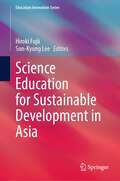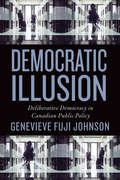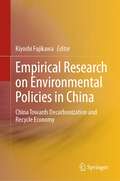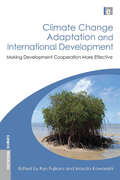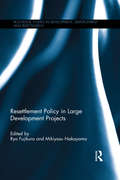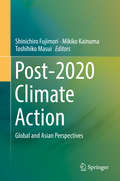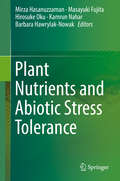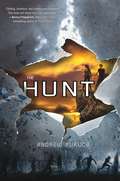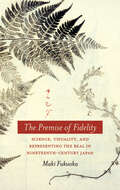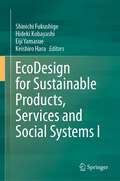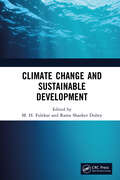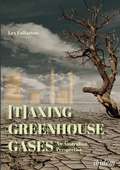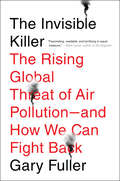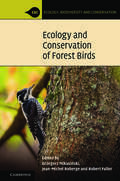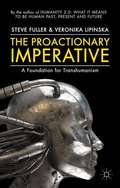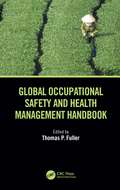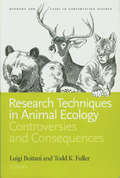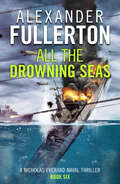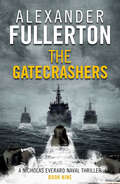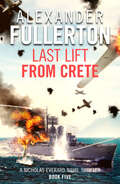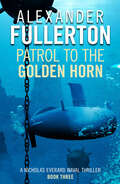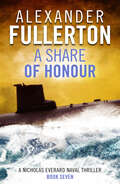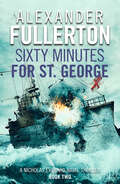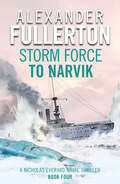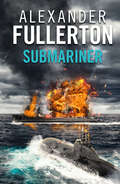- Table View
- List View
Science Education for Sustainable Development in Asia (Education Innovation Series)
by Hiroki Fujii Sun-Kyung LeeThis book presents an Asian perspective on transformative science education in the context of the United Nations' Sustainable Development Goals (SDGs). The chapters are written by contributors who practiced science education for sustainability in a research project entitled “Teacher Education for ESD in the Asia-Pacific Region” from 2017 to 2019, supported by the Japan Society for the Promotion of Science, and the Japanese National Commission for UNESCO. The book showcases the contributors’ innovations in science education for sustainability, presenting case studies of science teaching and learning, science curriculum and assessment, science education in collaboration with local communities, and science teacher education. Embodying Asian sustainability education paradigms, policies, and practices, these case studies depict the diversity and uniqueness of natural, social, and cultural contexts in Asia, while demonstrating their commonalities. Through examining these case studies, this book aims to provide examples for praxis, and prospects, for new science classes, curricula, and teacher education in implementing education for sustainable development.
Democratic Illusion
by Genevieve Fuji-JohnsonThe theory of deliberative democracy promotes the creation of systems of governance in which citizens actively exchange ideas, engage in debate, and create laws that are responsive to their interests and aspirations. While deliberative processes are being adopted in an increasing number of cases, decision-making power remains mostly in the hands of traditional elites.In Democratic Illusion, Genevieve Fuji Johnson examines four representative examples: participatory budgeting in the Toronto Community Housing Corporation, Deliberative Polling by Nova Scotia Power Incorporated, a national consultation process by the Canadian Nuclear Waste Management Organization, and public consultations embedded in the development of official languages policies in Nunavut. In each case, measures that appeared to empower the public failed to challenge the status quo approach to either formulating or implementing policy.Illuminating a critical gap between deliberative democratic theory and its applications, this timely and important study shows what needs to be done to ensure deliberative processes offer more than the illusion of democracy.
Empirical Research on Environmental Policies in China: China Towards Decarbonization and Recycle Economy
by Kiyoshi FujikawaThis book presents an empirical study of the effects of environmental policies on China and its neighboring countries, with a focus on waste and climate policies in China. The two major carbon policies have to do with carbon markets and renewable energy. The authors first examine the effectiveness of the Asian carbon market. Because of the consumption of goods beyond provincial borders, nationwide carbon markets are rather difficult to operate; therefore, a desirable initial allocation in the carbon market is proposed in this book. As for renewable power, its sources have not been fully utilized owing to a regional mismatch of supply and demand, so optimal locations of renewable energy are shown. The book also contains an analysis of the environmental and economic impacts of changes in resource circulation in East Asia. Although motorization is advancing rapidly, the vein industry for recycling used cars has not progressed. The authors estimate the amount of materials from used cars including new energy vehicles (electric and fuel cell vehicles) and propose desirable policies for used vehicles. East Asia is interdependent with respect to carbon and waste as well as the economy. China has regulated the import of waste recently and has started recycling its own wastes, putting pressure on neigboring countries to recycle their waste domestically. The authors estimate the environmental and economic impacts of such policy changes.
Climate Change Adaptation and International Development: Making Development Cooperation More Effective
by Ryo Fujikura Masato KawanishiClimate change impacts upon the world's poorest most heavily. It is therefore essential that international development initiatives focus on improving the ability of developing countries to adapt to the effects of climate change. This book, a product of research by the JICA-RI (Research Institute of the Japan International Cooperation Agency), examines climate change adaptation from the perspective of development cooperation in order to provide useful lessons for those engaged in research, policy and practice in this vital area. In this book the editors have brought together a wide range of case studies from across Africa and Asia, covering urban and rural areas and different sectors including water, agriculture and disaster management, in order to examine the following: o high-resolution climate change projection in Asia and how this can be used in planning appropriate adaptation responses o in-depth case studies of climate change projections, social, economic and environmental impact and vulnerability assessment and adaptation in rural Thailand and urban Philippines o cases across Africa for which climate data is less readily available and alternative approaches need to be adopted o the current situation amongst international donors o emerging issues caused by climate change In the introductory section, the editors draw together the full implications from the case studies to discuss how international communities can support adaptation in developing countries and to give an assessment of bilateral projects. They reflect on the lessons learned and offer recommendations for future research and international development cooperation.
Resettlement Policy in Large Development Projects (Routledge Studies in Development, Displacement and Resettlement)
by Ryo Fujikura Mikiyasu NakayamaHydropower generation by construction of large dams attracts considerable attention as a feasible renewable energy source to meet the power demand in Asian cities. However, large development projects cause involuntary resettlement. Of the world’s forty to eighty million resettlers, many resettlers have been unable to rebuild their livelihood after relocation and have become impoverished. This book uniquely explores the long-term impacts of displacement and resettlement. It shows that long-term post-project evaluation is necessary to assess the rehabilitation and livelihood reconstruction of resettlers after relocation. It focuses on large dam projects in a number of Asian countries, including Indonesia, Japan, Laos, Turkey, Sri Lanka and Vietnam, which are often ignored in Displacement studies in favour of China or India. Drawing on a wealth of empirical data over ten years, it presents crucial factors for successful resettlement by analysing lessons learned. The range of countries allow for a diverse and complex set of factors and outcomes to be analysed. Many of the factors for successful resettlement recur despite the cases being different in implementation period and location. The book presents highly original findings gathered by local researchers in the field directly talking to resettlers who were relocated more than a decade ago. This original book is a unique resource for researchers and postgraduate students of development studies, environment, geography, sociology and anthropology. It also makes policy recommendations for future resettlement programs that are of great value to development policy makers, planners, water resources engineers and civil society protest groups.
Post-2020 Climate Action
by Shinichiro Fujimori Mikiko Kainuma Toshihiko MasuiThis book summarizes assessments of the Paris Agreement to provide an excellent introduction to this research field. The AIM/CGE (Asia-Pacific Integrated Modeling /Computable General Equilibrium) model, which is the core of AIM modeling framework, is used for the assessment. The first part focuses on global issues, presenting both short-term (a few decades) and long-term (century scale) assessments in the context of the Agreement's ultimate climate goal. It also discusses policy implementation and climate risk. Part 2 is a collection of assessments of individual Asian countries, providing insights into the national situations and detailed analyses. It includes contributions from Asian countries as well as NIES (National Institute for Environmental Studies, Japan) members. The main conclusion is that many countries require changes to their energy systems change and societal transformation in order to meet emissions targets. Part 3 describes in detail the AIM/CGE model, which is used to evaluate the climate and energy policies by simulating the future economic and energy and environmental situation in the Asia-Pacific region. This section can be used as a standard text on CGE modelling in climate change mitigation.
Plant Nutrients and Abiotic Stress Tolerance
by Masayuki Fujita Mirza Hasanuzzaman Hirosuke Oku Kamrun Nahar Barbara Hawrylak-NowakThis book discusses many aspects of plant-nutrient-induced abiotic stress tolerance. It consists of 22 informative chapters on the basic role of plant nutrients and the latest research advances in the field of plant nutrients in abiotic stress tolerance as well as their practical applications. Today, plant nutrients are not only considered as food for plants, but also as regulators of numerous physiological processes including stress tolerance. They also interact with a number of biological molecules and signaling cascades. Although research work and review articles on the role of plant nutrients in abiotic stress tolerance have been published in a range of journals, annual reviews and book chapters, to date there has been no comprehensive book on this topic. As such, this timely book is a valuable resource for a wide audience, including plant scientists, agronomists, soil scientists, botanists, molecular biologists and environmental scientists.
The Hunt (Hunt Trilogy #1)
by Andrew FukudaDon't Sweat. Don't Laugh. Don't draw attention to yourself. And most of all, whatever you do, do not fall in love with one of them. Gene is different from everyone else around him. He can't run with lightning speed, sunlight doesn't hurt him and he doesn't have an unquenchable lust for blood. Gene is a human, and he knows the rules. Keep the truth a secret. It's the only way to stay alive in a world of night―a world where humans are considered a delicacy and hunted for their blood. When he's chosen for a once in a lifetime opportunity to hunt the last remaining humans, Gene's carefully constructed life begins to crumble around him. He's thrust into the path of a girl who makes him feel things he never thought possible―and into a ruthless pack of hunters whose suspicions about his true nature are growing. Now that Gene has finally found something worth fighting for, his need to survive is stronger than ever―but is it worth the cost of his humanity?
The Premise of Fidelity: Science, Visuality, and Representing the Real in Nineteenth-century Japan
by Maki FukuokaThe Premise of Fidelityputs forward a new history of Japanese visuality through an examination of the discourses and practices surrounding the nineteenth century transposition of "the real" in the decades before photography was introduced. This intellectual history is informed by a careful examination of a network of local scholars-from physicians to farmers to bureaucrats-known as Shohyaku-sha. In their archival materials, these scholars used the termshashin(which would, years later, come to signify "photography" in Japanese) in a wide variety of medical, botanical, and pictorial practices. These scholars pursued questions of the relationship between what they observed and what they believed they knew, in the process investigating scientific ideas and practices by obsessively naming and classifying, and then rendering through highly accurate illustration, the objects of their study. This book is an exploration of the process by which the Shohyaku-sha shaped the concept of shashin. As such, it disrupts the dominant narratives of photography, art, and science in Japan, providing a prehistory of Japanese photography that requires the accepted history of the discipline to be rewritten.
EcoDesign for Sustainable Products, Services and Social Systems I
by Shinichi Fukushige Hideki Kobayashi Eiji Yamasue Keishiro HaraThis 2-volume book highlights cutting-edge ecodesign research and covers broad areas ranging from individual product and service design to social system design. It includes business and policy design, circular production, life cycle design and management, digitalization for sustainable manufacturing, user behavior and health, ecodesign of social infrastructure, sustainability education, sustainability indicators, and energy system design. Featuring selected papers presented at EcoDesign 2021: 12th International Symposium on Environmentally Conscious Design and Inverse Manufacturing, it also includes diverse, interdisciplinary approaches to foster ecodesign research and activities. In the context of Sustainable Development Goals (SDGs), in particular SDG 12 (Responsible Consumption and Production), it addresses design innovations for sustainable value creation, considering technological developments, legislation, and consumer lifestyles. Further, the book discusses the concept of circular economy, which aims to develop circular business models for resource efficient society by taking advantage of digital technologies including artificial intelligence, internet of things, digital twin, data analysis and simulation. Written by experts from academia and industry, Volume 1 highlights sustainable design such as product and process design, collaborative design, sustainable innovation, digital technologies, design methodology for sustainability, and energy system design. The methods, tools, and practices described are useful for readers to facilitate value creation for sustainability.
Climate Change and Sustainable Development
by M. H. Fulekar Rama Shanker DubeyClimate Change and Sustainable Development covers the climatic and atmospheric changes, greenhouse gases and their impact on eco-system, biodiversity, water resources, agriculture and food security, human health, extreme weather and environment across two sections. The mitigation and adaptation strategies involving sustainable development is also illustrated including efficient technology, renewable energy, developmental activities control and so forth. Nanotechnology for sustainable development, forest protection, environment, social and economic sustainability and climate change policy planning of international bodies like UNFCC, UNDP, Kyoto protocol is also included. Features: Covers climate change fundamentals and its impact on different ecosystems and natural disasters Describes non-renewable energy aspects like fossil fuel, coal, oil, natural gas and so forth Explores sustainable development in terms of environment, social and economic aspects Includes species diversity and loss, agriculture productivity, water resources scarcity, health and environmental, rise in sea level and coastal area submergence Illustrates scientific hybridization of traditional ecological knowledge for enhancing climate change adaptation This book is aimed at graduate students and researchers in engineering and public policy, engineering management, sustainable engineering, renewable energy engineering, environmental engineering, and sustainability.
[T]axing Greenhouse Gases: An Australian Perspective
by Lex FullartonLex Fullarton takes a closer look at the three pillars of the sustainable development framework known as the “Triple Bottom Line” (TBL). The concept of the TBL is that for a project to be sustainable it must not simply be profitable in economic terms, but it must also benefit society and enhance the natural environment. In the twenty-first century, the greatest threat to Earth’s natural environment and the population of the planet is the rise of greenhouse gas emissions caused from burning fossil fuel as an energy source. The rise of GHG emissions has resulted in a rise in the ambient air temperature of the Earth’s atmosphere and is resulting in a significant change in climatic conditions on Earth.Fullarton scrutinizes the problem of getting industry and governments to understand the significance of creating harmony within the TBL. One of the main problems is that partisan politics tends to fragment the factors of the TBL rather than bring them together. Fullarton takes a strong stand in suggesting that taxation systems, which have traditionally been viewed primarily as a means of raising government finance, can be effectively applied to influence industrial and consumer attitudes towards transiting away from polluting fossil-fuel energy sources towards non-polluting renewable energy use.
The Invisible Killer: The Rising Global Threat of Air Pollution-and How We Can Fight Back
by Gary FullerAn urgent examination of one of the biggest global crises facing us today--air pollution--looking at the drastic worsening of the problem, and what we can do about it."Fascinating, readable, and terrifying in equal measure." —Mark Lynas, author of Six DegreesThe air pollution that we breathe every day is largely invisible—but it is killing us. How did it get this bad, and how can we stop it? Far from a modern-day problem, scientists were aware of the impact of air pollution as far back as the seventeenth century. Now, as more of us live in cities, we are closer than ever to pollution sources, and the detrimental impact on the environment and our health has reached crisis point. The Invisible Killer will introduce you to the incredible individuals whose groundbreaking research paved the way to today's understanding of air pollution, often at their own detriment. Gary Fuller's global story examines devastating incidents from London's Great Smog to Norway's acid rain; Los Angeles's traffic problem to wood-burning damage in New Zealand. Fuller argues that the only way to alter the future course of our planet and improve collective global health is for city and national governments to stop ignoring evidence and take action, persuading the public and making polluters bear the full cost of the harm that they do. The decisions that we make today will impact on our health for decades to come. The Invisible Killer is an essential book for our times and a cautionary tale we need to take heed of.
Ecology and Conservation of Forest Birds (Ecology, Biodiversity and Conservation )
by Robert J. Fuller Grzegorz Mikusiński Jean-Michel RobergeEcology and Conservation of Forest Birds is a unique review of the current understanding of the relationships between forest birds and their changing environments. Large ecological changes are being driven by forest management, climate change, introduced pests and pathogens, abiotic disturbances, and overbrowsing. Many forest bird species have suffered population declines, with the situation being particularly severe for birds dependent on attributes such as dead wood, old trees and structurally complex forests. With a focus on the non-tropical parts of the northern hemisphere, the text addresses the fundamental evolutionary and ecological aspects of forest birds using original data analyses and synthesising reviews. The characteristics of bird assemblages and their habitats in different European forest types are explored, together with the macroecological patterns of bird diversity and conservation issues. The book provides a valuable reference for ecologists, ornithologists, conservation professionals, forest industry employees, and those interested in birds and nature.
The Proactionary Imperative
by Steve FullerThe Proactionary Imperative debates the concept of transforming human nature, including such thorny topics as humanity's privilege as a species, our capacity to 'play God', the idea that we might treat our genes as a capital investment, eugenics and what it might mean to be 'human' in the context of risky scientific and technological interventions.
Global Occupational Safety and Health Management Handbook
by Thomas FullerThis book was written with the belief that everyone globally has the right to a safe and healthy workplace. An 8-year old carrying bricks in the mid-day sun in Nepal, a pharmaceutical business executive on assignment in Bangladesh, or a mother polishing stone in her home in Tanzania; each has a fundamental right to a workplace free from risk of injury, illness, and death. <p><p> Global Occupational Safety and Health Management Handbook is a broad presentation and discussion of the issues and obstacles facing the Occupational Safety and Health (OSH) profession today in providing safe workplaces globally. Readers can use this book to find resources to assist in the development of their programs and to become informed about the basic structures of international OSH development and governance. Readers can also rely on this book to become more aware of global OSH issues and problems that they may be personally or professionally willing and able to help address. Seasoned OSH professionals can expect to learn about new ways to look at complicated and controversial topics. Young professionals and students can read this book to better understand the important global OSH interrelationships and challenges of the future. <p><p> Features <li>Serves as a one-stop resource for information on important international safety and health topics and issues <li>Provides detailed information about international OSH tripartite, nongovernmental, and professional organizations <li>Describes the various global OSH educational and professional development needs, and international approaches to expanding capacity and awareness of the profession <li>Discusses controversial international OSH working conditions and explains their global impacts
Research Techniques in Animal Ecology: Controversies and Consequences (Issues, Cases, and Methods in Biodiversity Conservation)
by Todd Fuller Luigi BoitaniThe present biodiversity crisis is rife with opportunities to make important conservation decisions; however, the misuse or misapplication of the methods and techniques of animal ecology can have serious consequences for the survival of species. Still, there have been relatively few critical reviews of methodology in the field. This book provides an analysis of some of the most frequently used research techniques in animal ecology, identifying their limitations and misuses, as well as possible solutions to avoid such pitfalls. In the process, contributors to this volume present new perspectives on the collection, analysis, and interpretation of data.Research Techniques in Animal Ecology is an overarching account of central theoretical and methodological controversies in the field, rather than a handbook on the minutiae of techniques. The editors have forged comprehensive presentations of key topics in animal ecology, such as territory and home range estimates, habitation evaluation, population viability analysis, GIS mapping, and measuring the dynamics of societies. Striking a careful balance, each chapter begins by assessing the shortcomings and misapplications of the techniques in question, followed by a thorough review of the current literature, and concluding with possible solutions and suggested guidelines for more robust investigations.
All the Drowning Seas: The Nicholas Everard World War Ii Saga Book 3 (Nicholas Everard Naval Thrillers)
by Alexander FullertonThe sixth thrilling instalment of the Nicholas Everard thrillers. 1942. As Japanese invasion fleets sweep across the Pacific, a handful of Allied ships prepare for a last-ditch battle at Surabaya in the Java Sea. Not only is the Allied force doomed to defeat: any surviving ships will be trapped, since escape routes are blocked by the enemy. Nick Everard, commanding the cruiser Defiant, is badly wounded in the battle. His ship is heavily damaged and to make matters worse, he has a battered US destroyer under his protection. But unless Everard can find some way out of the trap, both ships and crews face destruction… All the Drowning Seas presents compelling action at sea, and establishes Alexander Fullerton as one of the premier novelists of naval warfare. Praise for Alexander Fullerton &‘The prose has a real sense of urgency, and so has the theme. The tension rarely slackens.&’ Times Literary Supplement
The Gatecrashers: The Nicholas Everard World War Ii Saga Book 6 (Nicholas Everard Naval Thrillers #6)
by Alexander FullertonThe extraordinary, breathless final volume in the Nicholas Everard Naval Thrillers.Six submarines are about to be towed underwater from Scotland to Norway. Their targets: the giant German warships Tirpitz, Scharnhorst and Lutzow.The odds seem stacked against the smaller craft. But if they can survive the nightmarish 2,000-mile tow, Commander Paul Everard will have a chance to gatecrash the fjords and cripple the ship Churchill calls ‘the Beast’.Whether or not he succeeds, the chances of getting out alive are slim. If he fails, his father Nick Everard, escort commander for Arctic convoy PQ19, is in trouble: none of his ships can stand up to Tirpitz’s broadsides. As The Gatecrashers draws to its thunderous climax, father and son face their final and most searching test…Based on the thrilling true story of Operation Source, The Gatecrashers is the blistering culmination of the bestselling Nicholas Everard Naval Thrillers, perfect for fans of Max Hennessy and Alan Evans.Praise for The Nicholas Everard Naval Thrillers‘The prose has a real sense of urgency, and so has the theme. The tension rarely slackens.’ Times Literary Supplement‘The research is unimpeachable and the scent of battle quite overpowering.’ The Sunday Times‘The accuracy and flair of Forester at his best… carefully crafted, exciting and full of patiently assembled technical detail that never intrudes on a good narrative line’ Irish Times
Last Lift from Crete: The Nicholas Everard World War Ii Saga Book 2 (Nicholas Everard Naval Thrillers #2)
by Alexander FullertonCrete, May 1941. Against all odds the Everards must survive a relentless Luftwaffe assault.The situation is dire for British forces in the Mediterranean. Their ships, with no air cover, have to run the gauntlet of 2,000 German bombers; and can only lick their wounds under cover of darkness.Nick Everard commands the destroyer Tuareg as it ventures well inside Stuka territory. There they are ordered to evacuate a body of troops, plus an Australian field hospital and thirty nurses, from right under the Germans’ noses. The soon-decimated flotilla has to make it round the Aegean, then out of Crete – but only a miracle can save them!Last Lift from Crete combines gripping personal drama with incredible naval action, and is a must-read for fans of Alistair MacLean and C. S. Forester.Praise for Alexander Fullerton‘Impeccable in detail and gripping in impact’ Irish Independent‘His action passages are superb and he never puts a period foot wrong’ Observer‘The research is unimpeachable and the scent of battle quite overwhelming’ Sunday Times
Patrol to the Golden Horn (Nicholas Everard Naval Thrillers)
by Alexander FullertonNicholas Everard is ready to run the gauntlet in his most dangerous mission yet…The menacing bulk of the German battlecruiser Goeben lurks in the Golden Horn of Constantinople. It is vital that she is destroyed, and the plan is to send an E-class submarine in through the Dardanelles to sink her unawares.But it has been two years since an Allied submarine passed through the narrow straits successfully, littered as they are with minefields, nets and depth charges dropped by the gunboats endlessly patrolling above.To send a crew in now would be a death sentence, but sparing the Goeben is unthinkable. Enter Nick Everard.An unputdownable story of the final days of WWI, perfect for fans of Douglas Reeman and Patrick O’Brian.Praise for Alexander Fullerton‘The most meticulously researched war novels that I have ever read' Len Deighton
A Share of Honour (Nicholas Everard Naval Thrillers #4)
by Alexander FullertonDanger lurks beneath the Mediterranean waves… Sub-lieutenant Paul Everard serves in the Mediterranean aboard the submarine Ultra, helping the Allies attack Axis supply ships in a life or death struggle beneath the waves. But Paul has other worries: his father, Nick, is somewhere in the Far East, at risk from the rapidly advancing Japanese. His brother, Jack, has become embroiled in the murky world of clandestine operations, and been sent on a high-risk mission to destroy a key German naval base.The Everards are risking everything for the war. But what price is too high for one family to bear? The seventh instalment of the Nicholas Everard Naval Thrillers is a searing adventure of warfare at sea, perfect for fans of Alan Evans and David McDine.Praise for The Nicholas Everard Naval Thrillers‘The prose has a real sense of urgency, and so has the theme. The tension rarely slackens.’ Times Literary Supplement‘The research is unimpeachable and the scent of battle quite overpowering.’ The Sunday Times‘The accuracy and flair of Forester at his best… carefully crafted, exciting and full of patiently assembled technical detail that never intrudes on a good narrative line’ Irish Times
Sixty Minutes for St. George (Nicholas Everard Naval Thrillers)
by Alexander FullertonChurchill called it the finest feat of arms of the Great War…After a punishing winter patrolling the Strait of Dover aboard HMS Mackerel, Nicholas Everard finds himself leading a secret mission to capture a German trawler. Little does he know it is all in preparation for the Zeebrugge Raid.As dawn breaks on St George’s Day, 1918, the Royal Navy launch a desperate assault on the Belgian submarine base, scuttling multiple blockships to trap the U-boats in the harbour.In sixty minutes of fire and fury, eight Victoria Crosses are won and hundreds of British sailors sink to their deaths. But will Nick be one of them?An extraordinary portrait of violence and valour, perfect for fans of C.S. Forester and Douglas Reeman.Praise for Sixty Minutes for St. George‘The research is unimpeachable and the scent of battle quite overpowering’ The Sunday Times
Storm Force to Narvik: The Nicholas Everard World War Ii Saga Book 1 (Nicholas Everard Naval Thrillers #1)
by Alexander FullertonEverard is returns in a new global conflict.British Captain Nick Everard's destroyer is crippled by Nazi gunfire in the German invasion of Norway. Nothing seems able to stop the advance across Europe and the Royal Navy is in a tight situation.Desperately attempting to repair his ship hidden in a remote fjord, Everard is unaware that his son is part of an Allied naval flotilla converging on Norway, and the two are fated to join forces in a deadly arctic battle.Moving into a new and explosive phase of Everard’s career, Storm Force to Narvik takes us deep into the action and danger of the Second World War.
Submariner
by Alexander FullertonAn epic Second World War adventure from the author of the Nicholas Everard naval thrillers, who &“recreates [life at sea] with authenticity and vigor&” (Historical Novel Society). As captain of the submarine Ursa, Lieutenant Mike Nicholson&’s mission is to disrupt the flow of war supplies to Rommel&’s Afrika Korps. Although Ursa is small, slow and often out-gunned, she succeeds, on her seventeenth Mediterranean cruise, in sinking a German tank-transporter. That triumph makes Mike top of the league—he has now sunk more tonnage than any of his contemporaries. Promotion to Lieutenant-Commander, at the age of twenty-eight, is on the cards. All he has to do is adhere to two rules: stay alive, and keep his nose clean . . . Submariner is a gripping Second World War naval thriller that will appeal to fans of Douglas Reeman and Jack Higgins. Praise for the writing of Alexander Fullerton &“His action passages are superb, and he never puts a period foot wrong.&” —The Observer &“You don&’t read a novel by Alexander Fullerton. You LIVE it.&” —South Wales Echo &“The research is unimpeachable and the scent of battle quite overpowering.&” —The Sunday Times
